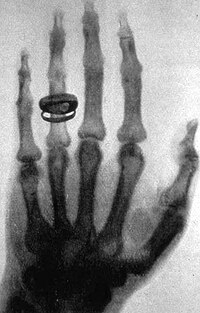
Photo from wikipedia
In healthcare, diagnostic tests are conducted to confirm the presence or absence of a pathology. The objective of testing is to increase the certainty about whether a particular pathology is… Click to show full abstract
In healthcare, diagnostic tests are conducted to confirm the presence or absence of a pathology. The objective of testing is to increase the certainty about whether a particular pathology is present or absent. Diagnostic tests can be differentiated from other types of clinical tests because they are used to determine the presence or absence of specific pathologies. Non-diagnostic clinical tests include tests that assess impairment, assess function, or monitor progress. Examples are muscle strength tests and range of motion tests. Other nondiagnostic clinical tests aim to predict conditions or symptoms in the future, or stratify people by expected response to treatment. An example is the STarT Back Tool for prognosis and stratified care of low back pain. Diagnostic tests are widely used in physiotherapy. An example of a diagnostic test used in the subdiscipline of musculoskeletal physiotherapy is the Lachman’s test of the anterior cruciate ligament; an example in cardiorespiratory physiotherapy is the use of lung ultrasound to identify pneumonia; and an example from the continence and women’s health subdiscipline of physiotherapy is the supine stress test of intrinsic urethral sphincter dysfunction in women. Accurate diagnoses may help physiotherapists structure appropriate management plans. Often there are several diagnostic tests that could be used to test for the same pathology. In musculoskeletal physiotherapy, one example arises when a physiotherapist aims to confirm the presence or absence of a meniscal lesion following an acute knee injury. Some of the diagnostic tests a physiotherapist could use to assess for meniscal lesions include McMurray’s test, joint line tenderness, Apley’s test, Payr’s test, the Thessaly test, and patient reports of locking of the knee joint. Another example from cardiorespiratory physiotherapy arises when a physiotherapist aims to confirm the presence or absence of chronic obstructive pulmonary disease. Some of the diagnostic tests a physiotherapist could use to assess for chronic obstructive pulmonary disease include auscultation, lung ultrasound, peak expiratory flow measurements, particular findings from a patient’s history, or a variety of questionnaires. The choice of a diagnostic test is influenced by many factors. Selection of a diagnostic test should be based, at least in part, on empirical evidence of the test’s accuracy in determining whether a pathology is present or absent. That evidence can be found in primary studies of diagnostic test accuracy and systematic reviews of primary studies of diagnostic test accuracy. Primary studies of diagnostic test accuracy measure the accuracy of diagnostic tests by comparing the results of the index test to those of a reference standard applied to the same subjects. Accuracy can be quantified in many ways, but it is most often quantified in terms of sensitivity and specificity, or likelihood ratios. The index test is the
Journal Title: Journal of physiotherapy
Year Published: 2019
Link to full text (if available)
Share on Social Media: Sign Up to like & get
recommendations!